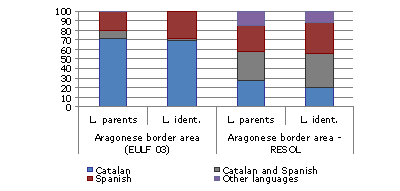 |
Table
5. Language used with parents and language of identity for the whole
population of the Aragonese border area and among pupils in the
sixth year of primary education in certain towns and villages in
the area.
| |
Language used with
parents |
Language of identity |
Aragonese
border area |
Aragonese border
area- ESOL |
Aragonese border
area |
Aragonese
border
area- ESOL |
N |
% |
N |
% |
N |
% |
N |
% |
| Catalan |
622 |
71,6 |
68 |
28,1 |
596 |
68,6 |
49 |
20,2 |
| Catalan and Spanish |
70 |
8,1 |
71 |
29,3 |
27 |
3,1 |
86 |
35,5 |
| Spanish |
170 |
19,6 |
66 |
27,3 |
243 |
28,0 |
78 |
32,2 |
| Other languages |
7 |
0,8 |
37 |
15,3 |
3 |
0,3 |
29 |
12,0 |
| TOTAL |
869 |
100 |
242 |
100 |
869 |
100 |
242 |
100 |
Note: Data for the Aragonese border area is from
the EULF 03 study. Data for the Aragonese border area - RESOL is
that used in the present study.
Figura 2. Llengua amb els progenitors i d’identificació
a la totalitat de la Franja
(EULF 03) i a la població escolar de sisè a poblacions
específiques de la Franja

To explain the differences between the language used with parents
and the language of identity, it is useful to examine the following
specific case: the language of identity of pupils who speak Spanish
with their parents (Table 6). The figures in the table show that
in both Mataró and the Aragonese border area the majority
of those who use Spanish with their parents identify with this language,
although the proportion is much higher in the Aragonese border area
than in Mataró (72.7% and 58.3% respectively), while those
who do not identify exclusively with Spanish identify with both
languages, especially in Mataró (37.3%).
Table 6. Language of identity of respondents
who use Spanish with their parents.
| |
Mataró |
|
Aragonese border
area |
N |
% |
N |
% |
| Catalan |
11 |
3,2 |
|
6 |
9,1 |
| Catalan and Spanish |
128 |
37,3 |
|
11 |
16,7 |
| Spanish |
200 |
58,3 |
|
48 |
72,7 |
| Other languages |
4 |
1,2 |
|
1 |
1,5 |
| TOTAL |
343 |
100 |
|
66 |
100 |
We can summarise the data in Tables 4 –
6 regarding language of identity and language used with one's
parents as follows:
1. The samples of sixth year primary
pupils in Mataró and the Aragonese border area are similar
in one important aspect: bilingual identification is the most
frequently occurring value in both populations (36.3% in Mataró
and 35.5% in the Aragonese border area) in contrast to the total
populations of Catalonia and the Aragonese border area, in which
the majority identify with one language, be it Catalan or Spanish.
2. Generally speaking, in the preadolescent population, both
in Mataró and in the Aragonese border area, the language
of identity and the language used with parents do not coincide,
the only exception being that of Catalan in Mataró. In
particular, we can observe the following trends:
• In Mataró the proportion
having Catalan as their language of identity is greater than
the percentage using it with their parents, while in the case
of Spanish the percentage using the language with their parents
is greater than the percentage who give it as their language
of identity. In the Aragonese border area these trends are reversed.
• There is a percentage of pupils
with both Catalan and Spanish as languages of identity who do
not use both with their parents: in Mataró 29.4% report
that they use both languages with their parents, while 36.9%
identify with both languages. In the Aragonese border area 29.3%
report that they use the two languages with their parents, but
35.5% identify with both languages.
3. In the case of respondents who use
Spanish with their parents, the lower proportion giving it as
their language of identity is largely accounted for by the percentage
identifying with both Catalan and Spanish.
4.2.
Descriptive analysis
For a closer study of the relationship between
language of identity and the language used with parents we will
study the case of pupils who use Spanish with their parents to
determine the factors which may account for their language of
identity. In particular the use of Spanish with parents and the
language given as language of identity are studied with regard
to five sociolinguistic variables which have been related to language
and identity in previous studies: language competence, social
networks, attitudes, confidence and the language spoken with siblings.
4.2.1.
Oral competence in Catalan
All the pupils in Mataró give themselves
high scores (average 9 on a scale out of 10) for oral competence
in Catalan. The average for pupils who use Spanish with their
parents is only 0.4 points less than the average for all the pupils
in the study. If we divide the pupils who use Spanish with their
parents into those who identify with both Catalan and Spanish
and those who identify only with Spanish, the former have scores
which are much closer to the average for all the pupils than the
latter.
|

